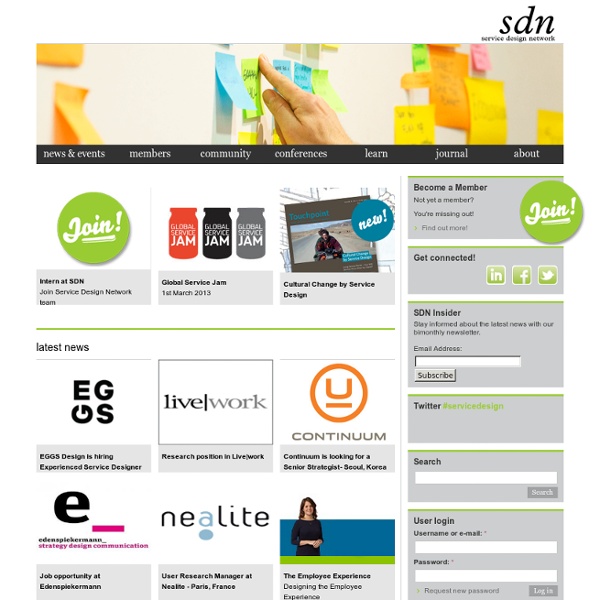



http://www.service-design-network.org/
Designing for Service: Creating an Experience Advantage Design We are surrounded by things that have been designed—from the utensils we eat with, to the vehicles that transport us, to the machines we interact with. We use and experience designed artifacts everyday. Yet most people think of designers as only having applied the surface treatment to a thing conceived by someone else. Eli Blevis created an illustration to emphasize the gulf between the general public’s notion of design and designer’s views of design (Blevis et al., 2006) (see Figure 19.1). Figure 19.1 – A caricature of the popular conception of design vs. all other concepts.
Participatory Design in Healthcare: Patients and doctors can bridge critical information gaps Born in Scandinavia in the mid-1960s under the moniker "cooperative design," what we now call participatory design went through a number of changes, and can be seen influencing urban design, architecture, community planning, and placemaking, as well as landscape design, product design, sustainability, graphic design, software design, and healthcare. The combination of the last two elements is the subject of this article. Most of us will agree that developing a model of a future healthcare IT product should involve professionals who are familiar with design thinking, and can apply usability best practices to design a solid product. Dieter Rams / Selector for 25/25 - Celebrating 25 Years of Design Dieter Rams Industrial Designer (1932-) Selector for 25/25 - Celebrating 25 Years of Design 29 March - 22 June 2007 As head of design at Braun, the German consumer electronics manufacturer, DIETER RAMS (1932-) emerged as one of the most influential industrial designers of the late 20th century by defining an elegant, legible, yet rigorous visual language for its products. Good design is innovative.
Mental models Open Access We believe in Open Access and the democratization of knowledge. Unfortunately, world class educational materials are normally hidden behind payment systems or in expensive textbooks. If you want this to change, you should help us out! Welcome to the Virtual Crash Course in Design Thinking Welcome to the d.school’s Virtual Crash Course resource page! We know not everyone can make a trip to the d.school to experience how we teach design thinking. So, we created this online version of one of our most frequently sought after learning tools. Using the video, handouts, and facilitation tips below, we will take you step by step through the process of hosting or participating in a 90 minute design challenge. If you choose to participate, in 90 minutes you will be taken through a full design cycle by participating in The Gift-Giving Project.
Experience Economy Strategies: Adding Value to Small Rural Businesses Introduction Nationally, the number of small, independently owned businesses is substantial, accounting for over 90% of all U.S. business activity (Scarborough & Zimmerer, 2006). Small firms also comprise a majority of rural business establishments (U.S. Small Business Administration, 2004) and are central to rural economic development (Muske & Stanforth, 2000; Muske, Stanforth, & Woods, 2004). From Google Ventures: 4 Steps For Combining The Hacker Way With Design Thinking Jake Knapp is like the middle-school teacher everyone should have had. Tall, with clear blue plastic glasses, he holds a classroom-clock-sized timer like a football while explaining the first activity of the day: an exercise called "Crazy 8s" that involves drawing eight different solutions, with 40 seconds for each, to address one design challenge. On a whiteboard nearby, he’s sketched out a five-step game plan for redesigning the Blue Bottle Coffee website.
How To Hold A Design Jam In 53 Minutes Matthew May became a designer in less than an hour. Push your creative limits by holding a design jam of your own. July 14, 2011 When the Hasso Plattner Institute of Design at Stanford University, aka the "d.school," announced a few weeks ago that they were holding an experimental crash course in design thinking free of charge for the first 200 people to sign up, I immediately signed up. Use design thinking for the fuzzy front end of organizational change [Design thinking] is the ability to create new options and build new products, services and experiences that gives design so much power. It is the ability to understand deeply cultures from digital social media networks to small villages in southern India that gives design its power. – Bruce Nussbaum I first came across the term design thinking a several years ago, through the writing of Tim Brown and Bruce Nussbaum, two early champions of the approach.
Digital Resources for the Jam While working away during the weekend, you will create material for upload. It might be presentations or films, and you must respect the copyright on any images, films, logos and especially music you use. Please do not use copyrighted material as one of the risks is that whatever you publish will soon be blocked. Ideo's David Kelley on "Design Thinking" The smell of ramen noodles wafts over the Stanford d.school classroom as David Kelley settles into an oversize red leather armchair for a fireside chat with new students. It's 80 degrees and sunny outside in Palo Alto, and as the flames flicker merrily on the big computer screen behind him, Kelley, founder of both the d.school and the global design consultancy Ideo, introduces his grad students to what "design thinking" — the methodology he made famous and the motivating idea behind the school — is all about. Today's task: Design a better ramen experience. Some students seem a little mystified, as they twirl noodles around their chop sticks. What does a "ramen experience" have to do with design?